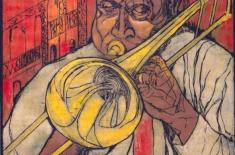Jazz Collection
At the core of the Louisiana State Museum's Music Collection is its internationally known Jazz Collection, the largest and most comprehensive of its kind in the world. The Jazz Collection chronicles the music and careers of the men and women who created, enhanced, and continue in the tradition of New Orleans jazz at the local, national, and international levels. It consists of instruments, pictorial sheet music, photographs, records, tapes, manuscripts, and other items ranging from Louis Armstrong's first cornet to a 1917 disc of the first jazz recording ever made. It includes the world's largest collection of instruments owned and played by important figures in jazz- trumpets, cornets, trombones, clarinets, and saxophones played by jazz greats such as Bix Beiderbecke, Edward "Kid" Ory, George Lewis, Sidney Bechet, and Dizzy Gillespie.
Other artifacts in the jazz collection include some 12,000 photographs from the early days of jazz; recordings in a wide variety of formats, including over 4,000 78 rpm records that date from 1905 to the mid-1950s, several thousand 12-inch LPs and 45 rpm records, and approximately 1,400 reel-to-reel tapes; posters, paintings and prints; hundreds of examples of sheet music from late 19th-century ragtime to popular songs of the 1940s and 1950s—many of them first editions that became jazz standards; several hundred rolls of film featuring concert and nightclub footage, funerals, parades, and festivals; hundred of pieces of relevant ephemera; and architectural fragments from important jazz venues.
Play to hear Lil Liza Jane from the Jazz Collection
History of the Jazz Collection
The New Orleans Jazz Club was founded in 1948 on Mardi Gras by a group of local jazz enthusiasts and musicians and has been going strong to this day. Almost immediately after it was founded the members began dreaming of opening a Jazz Museum, as many of them were collectors of jazz memorabilia and felt these should be made available to the public. The New Orleans Jazz Museum finally opened its doors in 1961 at 1017 Dumaine Street, and was a success from the start, so much so that it almost immediately began to outgrow the premises. Generous donations began to flood in, and within a few years, it became apparent that the cottage on Dumaine Street would not have sufficient space to keep up with the growth of the collection.
At about this time, the Royal Sonesta hotel opened on Bourbon Street, managed by a jazz enthusiast who offered display space on the balcony surrounding Economy Hall, the Hotel's nightclub that featured performances of jazz nightly. The Jazz Museum relocated there in 1969. When the manager, James Nassikas, was transferred to another Sonesta Hotel, the new management had different plans for that space, and in 1973 the Museum was forced to move to its third location at 833 Conti Street. Despite heroic efforts by the board and membership of the New Orleans Jazz Club, it eventually became financially impossible to keep the Museum open, and the collection was put in storage. The collection with its exhibit potential was as strong as ever but lacked a building to house it. At about this time, the Louisiana State Museum (LSM) was completing the renovation of the Old U.S. Mint at the foot of Esplanade Avenue, which it had acquired from the federal government in a rather decrepit state. When repairs were complete, LSM had a grand old building but lacked a star attraction exhibit to put in it. So on September 15, 1977, the two organizations solved each others' problems when the entire collection of the New Orleans Jazz Museum was donated to the people of Louisiana, and became The New Orleans Jazz Club Collections of the Louisiana State Museum.








